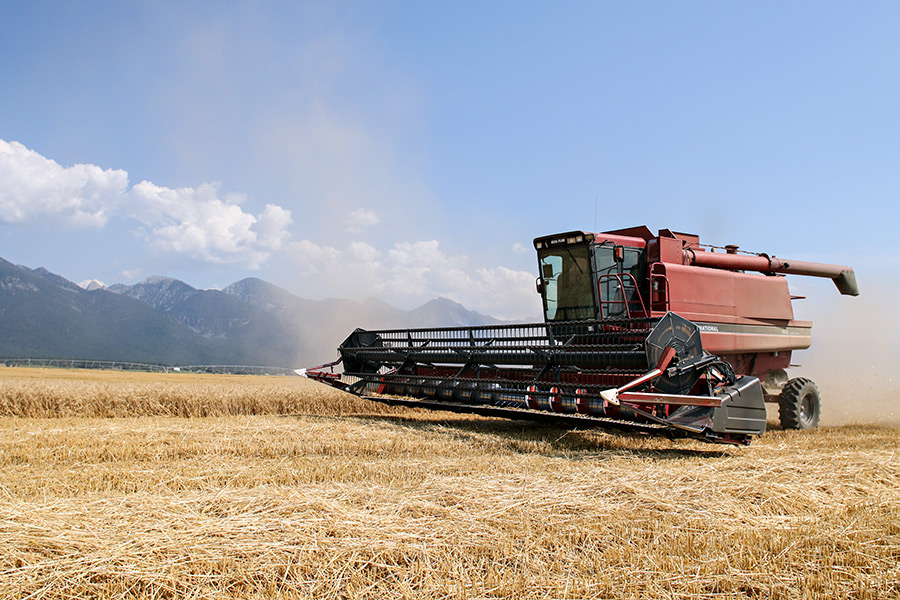BILLINGS – With cash grain prices at record highs and Russia’s war on Ukraine likely to push them higher still, one might assume that farm trucks would be lining up a mile deep at grain elevators hoping to cash in as they’ve done before.
Not so, says Mitch Konen. The Fairfield wheat farmer said many farmers, himself included, were hit so hard by the 2021 drought that it took everything they could harvest just to fill contracts that were supposed to be just 30% of what they would cut in a normal year.
“You see $10 cash prices, now. That’s only good if you’ve got it in the bin,” said Konen, past president of Montana Grain Growers Association. “There are probably not a lot of people who have grain in the bin to sell because they already sold it.”
Montana’s 2021 wheat harvest of 100.85 million bushels, was just 49% of the 10-year average, according to USDA’s National Agricultural Statistics Service.
The last time wheat prices were in this territory was 2008, the start of the Great Recession, a time when positive Montana grain sales buoyed a state economy that was being rocked by a collapse in the housing industry. It marked the first time state wheat sales were valued at $1 billion or more.
This round of robust prices might not produce the same outcome, as Montana farmers enter the second year of an extended drought with little wheat in reserves and farmers concerned about whether spring moisture will turn things around.
Prices were already trending upward before Russia invaded Ukraine, casting doubts of whether one of the biggest wheat-exporting regions in the world would be shipping grain in 2022 or selling at a price damaged by sanctions. Ukraine accounts for 20 million to 29 million metric tons of the world’s wheat exports, depending on the weather. That’s 10% to 15% of world exports, according to the U.S. Department of Agriculture.
If Ukraine wheat doesn’t ship, or planted acres are down, it will influence export prices, said Vincent Smith, economist at the Montana State University’s Department of Agricultural Economics and Economics.
“Exports, from all countries, all exporting countries, are getting close to 200 million metric tons, depending on the year, the weather,” Smith said. “So, we’re looking at a significant share of world exports.”
Farmers need to be thinking about crop insurance for the coming year and whether it makes sense to lock in contracts for fall delivery, Smith said.
Market prices are tempting. At local elevators a farmer with ordinary hard red winter wheat to sell could get $10.95 a bushel at Golden Triangle elevators, Tuesday, according to the U.S. Department of Agriculture. In Great Falls, the cash price was $10.89. Billings was a little lower at $10.35. Those prices are double what ordinary wheat was selling for during the same period last year. Ordinary wheat is typically the lowest priced variety, selling for less than wheat graded for higher protein.
Tuesday, September futures for hard red winter wheat on the Kansas City Board of Trade were at $9.97 a bushel. Hard red spring wheat September contracts finished at $10.10 on the Minnesota Grain Exchange, December contracts finished $10.09.
One thing Smith cautions consumers against is over associating bread prices with a beneficial increase in what farmers are paid for wheat.
“From the point of view of the price of a loaf of bread, folks need to understand that currently, for every dollar they spend on a loaf of bread, 94 cents of that is covering the cost of getting the wheat to the miller, to the baker, to the supermarket,” Smith said. “Only six cents of that, on average, is involved with purchasing the bushel of wheat from which the flour comes.”
“The issue, probably for all food prices, as well as every other price, is actually the impact of the Ukrainian crisis on the price of oil, diesel and the price of gas. But that’s the problem common to every commodity being produced, whether it’s a new Ford Escape, or a loaf of bread.”
There are factors other than the war pushing up the price of wheat, which was trending upward strongly before the invasion, said Cassidy Marn, Montana Wheat and Barley Committee executive vice president. It’s Marn who works directly with foreign buyers of Montana wheat. Much like Ukraine, Montana exports up to 80% of the wheat it grows. The state ranks third nationally in wheat production.
Drought is a big concern this year for U.S. wheat, not just in Montana.
“We also had some new drought monitor information come out, and it’s pretty bleak across the U.S.,” Marn said. “Montana’s certainly the worst. But it’s a pretty bad situation, we’re kind of getting into a pretty critical time for the Southern Plains, where they’re looking to harvest not too far out.”
The weather could turn around in the Southern Plains and the drought pressure on the U.S. wheat crop would diminish, Marn said. Another impactful turnaround would be a quick end to the Russian invasion of Ukraine.
Montana farmers aren’t strangers to mercurial shifts in grain production in the Black Sea region. In 2010, Montana grain prices jumped 60% in a little more than a month after drought-stricken Russia announced that its wheat production would be down 15 million metric tons. There had been a 23-million-ton surplus of wheat before the announcement by Russia. Suddenly, buyers that usually trade with Russia, namely Egypt and parts of Africa, were in the market for U.S. wheat.
Similarly in 2012, Ukraine announced that because of drought it wouldn’t be exporting as much grain in November. Montana benefited.
